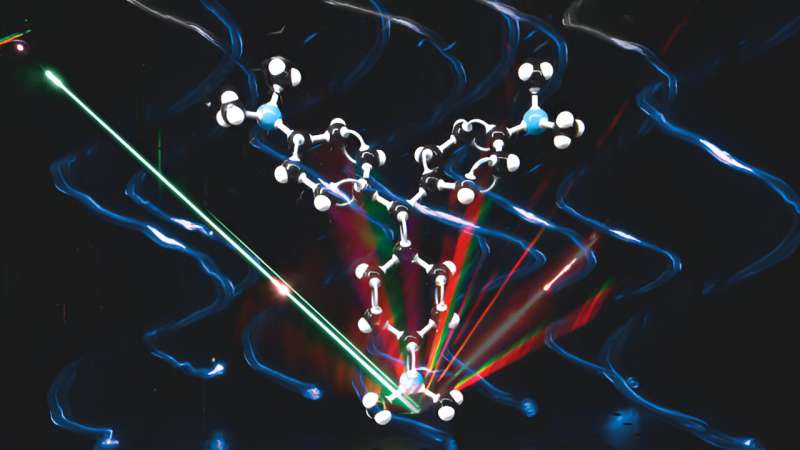New nanotech identifies chemical composition and structure of impurities in air, liquid and living tissue

An international team of scientists led by physicists at the University of Bath is contributing toward this technology, which may pave the way to new environmental monitoring methods and advanced medicines. Their work is published in the journal Advanced Materials.
The emerging chemical-detection technique is based on a light-matter interaction known as the Raman effect. The Raman effect occurs when a material that is illuminated at a certain color of light scatters and changes the light into a multitude of slightly different colors. It essentially produces a mini-rainbow that is dependent on how atoms within materials vibrate.
Measuring the colors of the Raman rainbow reveals individual atomic bonds because molecular bonds have distinct vibrational patterns. Each bond within a material produces its own unique color change from that of the illumination. Altogether, the colors in the Raman rainbow serve to detect, analyze and monitor the chemical composition (chemical bonds) of complex molecules, such as those found within mixtures of environmental pollutants.
Expanding, co-author Professor Liwu Zhang from the Department of Environmental Science at Fudan University in China said, "Aquatic pollutants, even in trace amounts, can accumulate in living organisms through the biological chain. This poses a threat to human health, animal welfare and wildlife. Generally, it is really hard to know exactly what the chemical composition of complex mixtures are."
Professor Ventsislav Valev from Bath, who led the study, added, "Understanding complex, potentially harmful pollutants in the environment is necessary, so that we can learn how to break them down into harmless components. But it is not all about what atoms they are made of. The way the atoms are arranged matters a lot—it can be decisive for how molecules act, especially within living organisms.
"Our work aims to develop new ways in which the Raman effect can tell us about the way atoms are arranged in space and now we have taken an important technological step using tiny helix shaped antennas made of gold."
The Raman effect is very weak—only one out of 1,000,000 photons (light particles) undergo the color change. In order to enhance it, scientists use miniature antennas fabricated at the nanoscale that channel the incident light into the molecules. Often these antennas are made of precious metals and their design is limited by nanofabrication capabilities.
The team at Bath used the smallest helical antennas ever employed: their length is 700 times smaller than the thickness of a human hair and the width of the antennas is 2,800 times smaller. These antennas were made from gold by scientists in the team of Professor Peer Fischer at the University of Stuttgart in Germany."Our measurements show these helical antennas help to get a lot of Raman rainbow photons out of molecules," said Dr. Jones. "But more importantly, the helical shape enhances the difference between two types of light that are often used to probe the geometry of molecules. These are known as circularly polarized light.
"Circularly polarized light can be left-handed or right-handed and our helices can, basically, handshake with light. And because we can make the helices twist to the left or to the right, the handshake with light that we devised can be both with left or right hands."
10th Edition of International Research Awards on Advanced Nanomaterials and Nanotechnology | 24-25 September 2023 | Mumbai, India (Hybrid)
Website: https://nanotechnology-conferences.sciencefather.com/awards/
#Nanotech #nanotechnology #Nanomaterials #Nanomedicine #Nanoparticles #Synthesis and Self Assembly of Nanomaterials #Nanoscale characterisation #Nanophotonics & Nanoelectronics #Nanobiotechnology #Nanocomposites #Nanomagnetism #Nanomaterials for Energy #Computational Nanotechnology #Commercialization of Nanotechnology #Nanotheranostics #Nanosensors and Actuators #Theranostic Device
Visit Our Conference Nomination: https://x-i.me/nanocon22
Visit Our Award Nomination: https://x-i.me/nanoawa22
==================
Website: https://nanotechnology-conferences.sciencefather.com/awards/
#Nanotech #nanotechnology #Nanomaterials #Nanomedicine #Nanoparticles #Synthesis and Self Assembly of Nanomaterials #Nanoscale characterisation #Nanophotonics & Nanoelectronics #Nanobiotechnology #Nanocomposites #Nanomagnetism #Nanomaterials for Energy #Computational Nanotechnology #Commercialization of Nanotechnology #Nanotheranostics #Nanosensors and Actuators #Theranostic Device
Visit Our Conference Nomination: https://x-i.me/nanocon22
Visit Our Award Nomination: https://x-i.me/nanoawa22
==================
Comments
Post a Comment